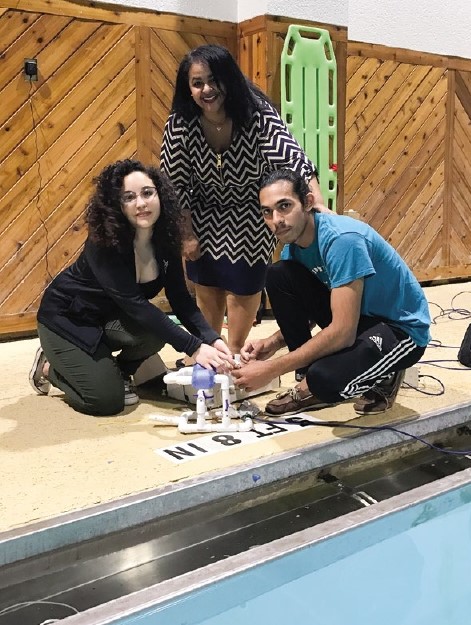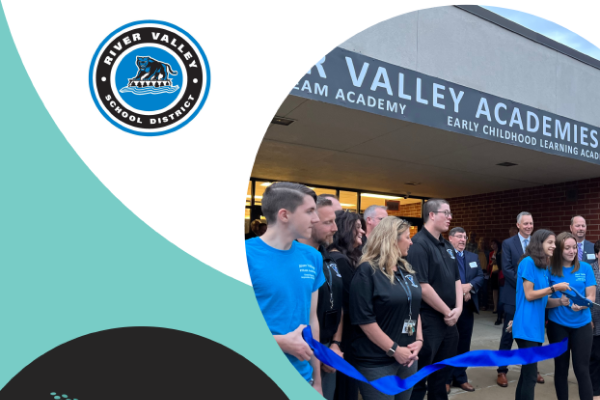STEM for all in Alief
May 01, 2017

It is a typical Saturday morning, almost 7:30 a.m., and Temour Baig and Talia Malin, students at Alief Early College High School, are wide awake and ready to apply their creative, problem-solving skills.
Baig, Malin and 140 fellow students plus a handful of faculty are gathered along the edges of the Alief district’s natatorium, where they will spend the morning designing, building, soldering and testing their SeaPerch robots. These sub-sea remotely operated vehicles, funded by Citgo, Houston Community College, the school district and the federal Office of Naval Outreach, help Baig, Malin and their classmates learn skills used by mechanical engineers. It is one of several initiatives that define the science, technology, engineering and mathematics program in the Alief Independent School District.
Located in Houston, the district has 47,000 students with 84 percent qualifying for free or reduced-price lunch. Alief is a culturally diverse school district with more than 80 languages and dialects spoken. We benefit from close proximity to many universities, companies and nonprofits.
Our goal — to provide high-quality STEM programming for all students in Alief ISD — is a work in progress, but one indicator of success is the eager participation of our students in national competitions involving the building of underwater robots and eco-friendly cars. We also see STEM is closing achievement gaps. Among students participating in STEM programs, the district is seeing about a 20 percent increase in the academic achievement compared to non-STEM peers in course grades and on high-stakes state exams.
Superintendent H.D. Chambers deserves much credit for the progress we have made. When he arrived in 2011, he frequently introduced STEM into conversations with staff and stakeholders. His focus continues to be on building the expectations required of teachers to prepare all students for postsecondary readiness.
In fall 2016, he set the expectations for all teachers during a broadcast to Alief’s 46 campuses: “(T)o leverage the creative innovators in our classrooms today, we must design meaningful learning experiences for our students, which will equip them with 21st-century skills.” He called for Alief’s educators to “cultivate an innovation mindset, whereby our students learn content at high levels, take risks, learn from mistakes and gain exemplary skillsets that will propel them to compete at the next level in life.”
In the same speech, Chambers added, “These types of actions are game changers for our students [who] should leave every classroom more eager to learn about that subject than when they arrived.”
Planting Seeds
The school district’s STEM plan started small and built momentum. Linking STEM learning to economic vitality, the district sought to change learning outcomes by raising the stakes. In a unique collaboration with Houston-area superintendents, JASON Learning and Chevron, they formed a public-private-nonprofit model for STEM that would be sustainable. This new paradigm for STEM programming highlights an intentional collaboration with a public school district, a STEM corporate partner and a nonprofit STEM curricula provider to cultivate a pipeline to STEM careers.
The trio meets several times a year to discuss the progress of STEM programming and its sustainability in the classroom and cultivates experiences for educators and students outside the classroom.
In summer 2012, Alief’s STEM program began in-depth professional development. A 28-member delegation of principals, coordinators, specialists and teachers attended JASON’s National Educators’ Conference where sessions focused on the opportunities it offers teachers and students. These include participating in field-based investigations with scientists, accessing course content linked to current research by scientists, hosting researchers’ visits in school districts and participating in highly engaging games and labs that include field assignments.
Grassroots Actions
After more than three years, the model for STEM and the relationship with JASON Learning were firmly in place, and Alief was ready for a STEM cultural expansion. A core district STEM committee consisting of three principals, four coordinators and two intervention specialists was given a complex goal: Build a strategic plan for a multigrade-level STEM Academy with a school-within-a-school focus.
The committee dove in, researching K-12 STEM practices, reviewing existing resources and program structures in Alief and other districts, and picking up new ideas at professional conferences, such as the Texas STEM Conference and the National Science Teachers Association’s STEM Forum. For strategic plan guidelines as they built a STEM blueprint, they relied on Educate Texas, a public-private group that houses the T-STEM Academies network for the state of Texas. Then the committee established a timeline for implementation by grade levels at its school-within-a-school model academy, which was established at two Alief middle schools and one high school. The Alief ISD T-STEM Academy opened in the 2015-16 school year.
The plan calls for building a STEM network incorporating community and corporate partners in the STEM and health-care fields, informal organizations such as museums, governmental agencies such as the FBI, higher education, STEM professional development entities, and schools designated by Educate Texas as T-STEM Academies.
Elementary campuses introduce STEM using JASON Learning and Engineering is Elementary and adopt Girl Start, which is an educational program to increase girls’ interest and engagement in STEM. In addition, we draw up professional development plans that infuse STEM practices in all secondary campuses.
Network Building

We’ve developed formal and informal relationships with STEM organizations, nonprofits, higher education and businesses. Bolstered with the support of oil and gas giants like Chevron, Citgo and Shell, along with organizations such as the American Society of Mechanical Engineers, Alief has been able to provide resources to campuses and gain access to industry experts.
In addition, higher education support from Houston Community College, Prairie View A&M University, Texas A&M University and others helped the district monitor the progress of the STEM practices we were using. They collaborate with us on grants, meet with a STEM coach and provide college mentors.
Nonprofit organizations such as the Bernard Harris Foundation, the American Association of University Women and others provided support by sponsoring STEM summer camps, women in STEM events and engaging curricula, such as JASON Learning. The Department of Naval Outreach in Houston trained teachers how to design, build and compete with robotics and educated students about postsecondary employment opportunities in the armed forces. Connections with local museums extended the learning for students.
By and large, we’ve found that building a cohesive and extensive STEM network truly enhances the quality of experiences for students and teachers. Formal and informal relationships with STEM organizations, higher education and the military enrich the curricula and lead to mentorships for students and staff and professional development for teachers. The external community plays a significant role.
Teacher Impacts
Gone are the days of teaching vintage lessons from a textbook. Our STEM teachers design lessons using state standards and real-world data sets with problem- and project-based scenarios. Students are learning about the earth using images from space, designing roller coasters virtually and testing their effectiveness using JASON Learning’s Coaster Creator game. All the while, they are writing in interactive notebooks in the manner of scientists, historians, journalists and mathematicians.
To make learning engaging, teachers use an array of STEM instructional practices: project-based learning, action-based learning, claim evidence reasoning, 3-D printing, Talk Read Talk Write protocols, card sorts and four corner discussions. College-prep strategies such as Cornell notes and tools to support English language learners are integrated throughout the STEM program. Performance assessments serve as guides for measuring academic growth during which students generate their own questions to solve problems, design solutions and find multiple ways to express their learning.
Student Impacts
Classroom instruction is changing. During classroom observations, Chambers sees instruction is “moving from a fixed mindset where students come to school to learn how the world exists.” He says teachers are helping students to be “discoverers” of new knowledge at school and develop the skills to innovate future industries, while readying high school graduates for postsecondary studies. This emergent thinking helps cultivate interactive learning using 21st-century skills.
All Alief students participate in STEM field experiences, including the JASON Learning Argonaut program, visit medical schools and museums and engage with robotics and the National Academy of Engineering’s 14 Grand Challenges of the 21st century. Students work to solve real-world challenges such as access to clean water, improved cybersecurity and affordable solar energy.
Each year brings new opportunities to improve. Soon, we will focus on how to expand high school students’ options for STEM internships and capstone projects. In the coming year, we also will work on integrating the arts into all content.
Author
Advertisement
Advertisement
Advertisement
Advertisement


